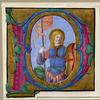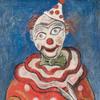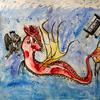Three Major Institutions Collaborate on First Major Exhibition Devoted to Matisse in the 1930s
- April 19, 2022 13:16
The Philadelphia Museum of Art, in collaboration with the Musée de l’Orangerie in Paris and the Musée Matisse Nice, will present the first exhibition ever dedicated to the pivotal decade of the 1930s in the art of Henri Matisse (1869–1954), one of the giants of twentieth-century art. Opening first in Philadelphia (October 19, 2002 to January 29, 2023), the only United States venue, the exhibition Matisse in the 1930s will present more than 100 works, ranging from both renowned and rarely seen paintings and sculptures, to drawings and prints, to illustrated books. It will also feature documentary photographs and films. The exhibition will be accompanied by a lavishly illustrated scholarly catalogue. Matthew Affron, Muriel and Philip Berman Curator of Modern Art at the Philadelphia Museum of Art; Cécile Debray, President of the Musée National Picasso-Paris; and Claudine Grammont, Director of the Musée Matisse Nice, comprise the curatorial team.
Affron stated: “Because this transformative decade in Matisse’s career has never been treated in a standalone exhibition before, visitors will have a rare opportunity to immerse themselves in the very process through which Matisse generated a new creative approach and outlook in the later part of his career, while also witnessing the dramatically revitalized production that followed from his eventful visit to Philadelphia in 1930. Only through such an institutional partnership can we so vividly tell this story, as each of our collaborating museums is uniquely and deeply connected to Matisse. Between works on view at the Philadelphia Museum of Art and complementary holdings down the street at the Barnes Foundation, Philadelphia this fall will be an especially exciting city in which to experience Matisse’s extraordinary art.”
“Matisse spent most of his life in Nice, and Mediterranean splendor permeates his work,” added Claudine Grammont. “He came back from the U.S. to France with a broadened vision of the world that had long-lasting effects, as the ’30s were rejuvenating for this pioneer of modernity. A new Matissian ‘map’ was drawn with the commission of a mural for the Barnes Foundation: it was consequently between Philadelphia and Nice that the main axis for these decisive years runs. The Musée Matisse in Nice, whose collection is rich in art linked to this period of creation, is particularly happy to collaborate with the Philadelphia Museum of Art and the Musée de l’Orangerie to demonstrate the powerful renewal in the artist’s work during this key period.”
Cécile Debray said: “The Dance (1931–33), Matisse’s decoration for the Barnes Foundation, is closely linked to the artist’s return to a modernist style in the 1930s. These years, when Matisse was inspired by his trips to the United States, when he was promoted in Paris by the journal Cahiers d’art, faced off with Picasso at the Paul Rosenberg gallery while his radical pre–World War I paintings were seen at Paul Guillaume’s, assisted the organization of different retrospective exhibitions, and worked on his art in Nice, made history as the crucible of a fascinating modernist transformation.
“Our three museums in Philadelphia, Paris, and Nice offer a special, much-anticipated opportunity for a new and unparalleled exhibition about this decade. Above all, the collaboration marks a friendship. I would like to salute Claudine Grammont and Matthew Affron, my friends and colleagues.”
A Pivotal Decade
In 1930, Matisse had achieved significant international renown, and yet he found himself in a deep creative slump. A dozen years before, he had switched his base of operations from Paris to Nice. There he had focused on the theme of female models in elaborately decorated studio setups bathed in the unvarying, crystalline light of the Mediterranean. Faced with the seductiveness of that body of work, some critics wondered whether Matisse, who had been such a radical force in modern painting, had lost his experimental edge. By the later 1920s, Matisse himself had developed second thoughts, and for a couple years he produced nearly no new paintings. The turning point came in the fall of 1930, when the artist visited the Barnes Foundation in the suburbs of Philadelphia, and received the commission for a three-part mural, The Dance.
Matisse used this commission to turn his work around. Afterward, he returned to easel painting with new procedures and a new approach. He started using photography systematically to document the cumulative process of building his motifs and to test his own reactions as he went along. He also began using pre-colored cut papers to plan his compositions; this procedure led him away from the illusion of modeling and deep space and toward a style of flat tones and bold shapes that gave his compositions of the 1930s a new impact.
Matisse in the 1930s will assemble a rich array of works from public and private collections in the United States and Europe. It will explore the remarkable changes in style that followed as Matisse discovered different ways of working across the mediums of easel and decorative painting, sculpture, printmaking, drawing, and the illustrated book. The exhibition will demonstrate that what he achieved during the 1930s represented nothing less than a total revitalization of his artistic vision.
Organization of the Exhibition
The narrative is organized chronologically, with a prelude called Interiors and Odalisques that looks at Matisse’s so-called Nice period of 1917–30. This section will focus on the artist’s depiction of studio models, often in settings filled with decorative textiles and other items from various regions of the Islamic world that Matisse visited; it will feature such important works as The Three Sisters (1917, Musée de l’Orangerie) and Woman with a Veil (1927, Museum of Modern Art), which will offer viewers a chance to examine Matisse’s attempt to synthesize decorative design, fashion, and the sensuality of the female figure into a modern aesthetic idiom, an effort much debated both in its day and in more recent years.
The second section will look at Matisse’s reinvigoration of his art through two parallel projects: the Barnes mural, which was his first and only opportunity to make a painted decoration for a specific architectural space, and his first major illustrated book, an edition of poems by the influential Symbolist poet Stéphane Mallarmé (1842–1898), which evoked a world of antiquity filled with dream and pleasure. This section will highlight a plethora of studies for the mural in pencil, gouache, and oil lent by the Musée Matisse Nice, including the nearly eleven-foot-tall Drawing at the Scale of the Central Figure of Barnes Mural (1930–31). To further convey the process of making that mural, which remains permanently housed at the Barnes Foundation nearby the Philadelphia Museum of Art, the exhibition will include a short amateur film showing Matisse at work on the massive design in the rented garage in Nice that served as his workspace, as his dog Raudi bounds friskily about.
The visitor will next encounter a section called Artist and Model that examines Matisse’s move to a bold, elemental style in drawings and easel paintings of the nude figure. A premier example is Large Reclining Nude (1935, Baltimore Museum of Art), which exemplifies the artist’s powerful use of flat forms to sublimate the sensuality of the subject into the orchestration of the composition. The following section, Painted Decorations, will examine Matisse’s continuing engagement with a decorative and architectural mode through his experiments in the genre of painted tapestry cartoons. A spectacular example, Nymph in the Forest (Verdure) (1935–42/43, Gift of Madame Jean Matisse to the French State on deposit at the Musée Matisse Nice, 1978, Musée d’Orsay), would occupy Matisse’s attention over eight years and become a true artistic touchstone for him. The next section, Working in the Studio, will follow Matisse’s development starting in 1936 of a series of images of models posing in fashionable European attire. The visible décor of the studio interior—with bouquets, mirrors, works of art, and large succulent plants—supported Matisse’s decorative concept of the image. A key picture in this section is Woman in Blue (1937, Philadelphia Museum of Art), which depicts Lydia Delectorskaya (1910–1998), Matisse’s secretary and studio manager, and in this period, his principal model, clad in a ruffled silk bodice with lace edging and matching skirt that she fabricated at the artist’s request. This ensemble inspired the bold visual design of Woman in Blue; the actual skirt will be displayed alongside the painting to underscore the productive collaboration between model and artist.
A compact section called A Mural in Motion will signal the continuing importance for Matisse at the end of the decade of his mural The Dance. In 1938–39, Matisse collaborated with the Ballets Russes de Monte-Carlo in the creation of a ballet called Red and Black (also known as Strange Farandole after a traditional Provençal dance that had inspired numerous works by the artist). Matisse designed the costumes, the stage curtain, and a backdrop laid out in three vaults to distinctly echo the Barnes mural. The costumed dancers supplied the mobile element in the performance. This section will feature one of the studies of a dancer that Matisse made in pre-colored cut papers—a technique that he had been using strictly for expedience in his studio practice but that would blossom in the 1940s into a full-fledged artistic procedure. A film of the troupe performing Red and Black made by an American dance critic in Chicago in 1939 will help bring this little-known modern ballet to life in the exhibition.
The narrative of Matisse in the 1930s closes with an epilogue centered on a major turning point that came soon after the end of the decade. In January 1941, Matisse underwent a risky operation for abdominal cancer; after this brush with death, he spoke of embarking on a second artistic life. At first, he painted little, but instead focused on a major effort in drawing: a corpus of 158 drawings of models in the studio and fruit and floral still lifes known as Themes and Variations. The exhibition’s epilogue will highlight two complete sets of Themes and Variations drawings—together with a small selection of contemporaneous paintings on the same subjects—as Matisse’s summation of what he had accomplished in the previous ten years. With their serial and open-ended approach—as in Theme P, which depicts a woman in a pleated dress in a variety of poses—the Themes and Variations confirmed that, as the 1930s turned to the 1940s, Matisse’s notion of creative process prioritized the flux of fleeting perceptions and emotions over the fully finished, definitive statement.

















__Buffalo_Hunt100x100_c.jpg)


